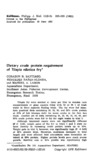Dietary crude protein requirement of Tilapia nilotica fry

Quan điểm/
Request this document
Ngày
1982Page views
182metadata
Hiển thị bản ghi đầy đủ mặt hàng
Share
trừu tượng
Tilapia fry were stocked at three per liter in wooden tank compartments or glass aquaria filled with 50 or 35 l of fresh water in three separate feeding trials. The fry were fed isocaloric practical diets containing 20, 25, 30, and 35% crude protein at 15% of fish biomass daily for seven weeks in the first tow trials. Another set of diets containing 20, 25, 30, 35, 40, 45, and 50% crude protein were fed to fry for eight weeks in trial 3.
Although treatment means were not significantly different (P< 0.05), weight gains of the fry in trials 1 and 2 were related directly to increasing crude protein levels up to 35%. Weight gain in trial 3, however, was significantly high (P < 0.05) at 35% protein level. Moreover, maximum increases in total length and most efficient feed conversions were invariably attained at 35% protein. Higher protein levels gave much poorer growth. Survival rate at 35% protein was significantly high (P < 0.05) compared to 20% (trial 1) or 30% (trial 2) protein level. In trial 3, survival at 35% protein was not significantly different from all other treatments. Maximum growth, best feed conversion, and high survival were attained with the 35% protein diets.
Suggested Citation
Santiago, C. B., Bañes-Aldaba, M., & Laron, M. A. (1982). Dietary crude protein requirement of Tilapia nilotica fry. Kalikasan: The Journal of Philippine Biology , 11(2-3), 255-265. http://hdl.handle.net/10862/1048
Chủ thể
Bộ sưu tập
- AQD Journal Articles [1215]

